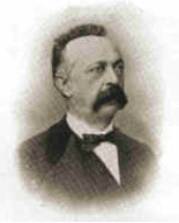Bartolomeo Gastaldi
Bartolomeo Gastaldi (1818-1879)

1818
Born in Turin, since he was a boy he made repeated naturalistic excursions in the surroundings of Turin and in the area of Astigiano, collecting various fossils which became the core of his private collection.
1839
Following his father’s will, a lawyer of the Court of Turin, he graduated in Law and practiced the profession for various years.
1843
After his father’s death he abandoned the practice of law and dedicated himself to Geology and Paleontology. He put together his own collection making several travels around Italy.
1844-46
His rich scientific production started with two letters addressed to the Geological Society of France regarding the discovery of a Pentacrinite and its attribution to the Miocene period.
1846
He travelled to Spain.
1849-52
He went to Paris to complete his studies of Geology and Paleontology.
He attended courses held by E. de Beaumont at the École des Mines, the Jardin des Plantes, the Collège de France and the Sorbonne.
He met Quintino Sella, with whom he established a deep and long-lasting friendship.
In particular, he dedicated himself to studying Glaciology and was in contact with specialists such as C. Martins and G. de Mortillet, with whom he started various collaborations.
1851
He printed in Turin Ricerche sul periodo glaciale, the translation of a work by Martins, adding several notes and a chapter on the Dora Baltea and Dora Riparia glaciers.
1853
Having returned to Turin, he continued studying Glaciology and Paleontology, dedicating himself to his private collection of fossils and minerals.
1854
He was appointed by Sella (who was at the time a Professor of Geology at the Istituto Tecnico del Valentino) to rearrange the mineralogical collection of V. Barrelli, enriched by Sella’s private collection of crystals.
He was appointed Secretary of the Istituto Tecnico.
He became interested in Paleoetnology following the discovery in Zurich of some settlements built on piles and he started extensive researches on prehistoric settlements in Italy.
1855
He was appointed Head of the Ufficio Centrale delle Privative Industriali.
1860
He remained Secretary of the Istituto Tecnico, that Q. Sella had transformed into the Scuola di Applicazione per gli Ingegneri.
He found and described flint, bronze and wooden objects and weapons originating from the peat bogs near Arona and Imola and from the marls of Emilia Romagna and Lombardy (1860-62).
1861
He was appointed Mineralogy and Geology Assistant to Q. Sella’s chair.
1863
He became full Professor of Mineralogy and Geology when Q. Sella stopped teaching and dedicated himself to politics.
He donated his paleontological collection to the Scuola di Applicazione. It is currently kept at the Museo del Dipartimento di Scienze della Terra of the University of Turin.
1863-68
He studied the origin of lakes in morainic amphitheaters.
1863
He was among the founders of the Italian Alpine Club, of which he became the Vice President and first drafter of the Bulletin (1864-73).
In 1876
He was appointed President.
from 1864
He drew up the Geological Map of Biella with Q. Sella and G. Berruti.
During this project, he thought of drawing up the Geological Map of the Alps of Piemonte, which he carried out in 14 years. He mapped on several sheets (colouring with geological criteria the Staff’s topographical map at a scale of 1:50,000) the Alps lying between the Dora Baltea and the Tanaro covering an area of about 16,000 square kilometres.
1867
He became teacher of Geology and Mineralogy at the Scuola Superiore di Guerra.
He became a member of the Italian Geological Committee.
from 1875
He became the Director of the Museo Civico of Turin.
1878
When the respective Mineralogy and Geology museums and chairs were separated, he became Professor of Geology at the University of Turin.
1879
He died in Turin.
During the course of his life, he was repeatedly awarded prizes and became member of several Italian and foreign scientific academies such as: Accademia dei Lincei, Accademia Nazionale delle Scienze (so-called “Academy of the XL”), R. Accademia d’Agricoltura di Torino, Geological Societies of London and Vienna.
He was author of several essays and monographs and he gave his name to Gastaldite, a variety of glaucophane (magnesium and calcium silicate) originating from Val Chisone and Valle d’Aosta.
